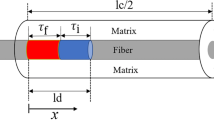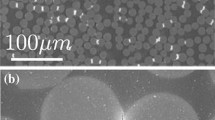Abstract
Dynamic photoelasticity has been used to study the effect of the fiber-matrix interface and fiber orientation on dynamic crack growth in fiber composites. Two types of fiber-matrix interfaces are considered: well bonded and partly debonded. The fiber-matrix interface is characterized by conducting fiber pullout tests. Partly debonded fibers aligned with the loading direction, result in higher fiber debonded lengths, lower dynamic stress-intensity factorK ID and lower fracture surface roughness compared to well bonded fibers. Orientation of brittle fibers, with respect to the loading direction, impairs their ability to lowerK ID , while oriented ductile fibers produce no significant change inK ID . Misalignment of fibers from the loading direction reduces the fiber debonded length due to kinding of the fiber at the crack face.
Similar content being viewed by others
References
Williams, M.L., ‘The Stress Around A Fault Or Crack In Dissimilar Media,’Bull. Seismological Soc. of Amer. 49,199–204 (1957).
Hutchinson, J.W., Mear, M. andRice, J.R., ‘Crack Paralleling an Interface Between Dissimilar Media,’J. Appl. Mech.,54,828–832 (1987).
Rice, J.R., ‘Elastic Fracture Mechanics Concepts For Interfacial Cracks,’J. Appl. Mech.,55,98–103 (1988).
Tippur, H.V. andRosakis, A.J., ‘Quasi-Static and Dynamic Crack Growth Along Bimaterial Interfaces: A Note on Crack Tip Field Measurements Using Coherent Gradient Sensing,’Experimental Mechanics,31 (3),243–251 (1991).
Cao, H.C. andEvans, A.G., ‘An Experimental Study of the Fracture Resistance of Bimaterial Interfaces,’Mechanics of Materials,7,295–304 (1989).
Charlambides, P.G. andEvans, A.G., ‘Debonding Properties of Residually Stressed Brittle Matrix Composites,’J. Amer. Cer. Soc.,72 (5),746–753 (1989).
International Conference on Composite Interfaces (ICCI-II), ed. H. Ishida Cleveland (1988).
Materials Research Society Symp. Proc., ed. G.G. Pantano andE.J.H. Chen, 170, Mat. Res. Soc., Pittsburgh, (Nov. 1987).
Broutman, L.J., ‘Measurement of the Fiber-Polymer Matrix Interfacial Strength,’ASTM STP 452,27–41 (1968).
Greszczuk, L.B., ‘Theoretical Studies of the Mechanics of the Fiber-Matrix Interface in Composites,’ASTM STP 452,42–58 (1968).
Atkinson, C., Avila, J., Betz, E. andSmelser, R.E., ‘The Rod Pull-out Problem Theory and Experiment’,J. Mech. and Physics of Solids,30 (3),97–120 (1982).
Piggot, M.R., ‘Tailored Interfaces in Fiber Reinforced Polymers,’J. Comp. Mat.,13,265–274 (1990).
Hsuesh, C.H., ‘Interfacial Debonding and Fiber Pullout Stresses of Fiber Reinforced Composites,’Mat. Sci. and Eng.,A123 (1),1–11 (1990).
Ravi-Chandar, K. andKnauss, W.G., ‘An Experimental Investigation Into Dynamic Fracture II: Microstructural Aspects,’Int. J. Fract.,26,65–80 (1984).
Arakawa, K. andTakahashi, K., ‘Relationships Between Frecture Parameters and Fracture Surface Roughness of Brittle Polymers,’Int. J. Fract.,48,103–114 (1991).
Shukla, A. andKhanna, S.K., ‘Effect of Fiber Reinforcement on Dynamic Crack Growth in Brittle Matrix Composites,’Trans. ASME, J. Eng. Mat. and Tech.,115,140–145 (Jan. 1993).
Shukla, A. andChona, R., ‘The Stress Field Surrounding a Rapidly Propagating Curving Crack,’ASTM STP 945,86–99 (1988).
Irwin, G.R., ‘Series Representation of the Stress Field Around Constant Speed Cracks,’ Univ. of Maryland Lecture Notes (1980).
Sanford, R.J. andDally, J.W., ‘A General Method for Determining Mixed mode Stress Intensity Factors From Isochromatic Fringe Patterns,”Eng. Fract. Mech.,11 (4),621–633 (1979).
Tada, H., paris, P.C. and Irwin, G.R., “The Stress Analysis of Cracks Handbook,” Del Research Corp., 2–27 (1973).
Khanna, S.K., ‘Effect of Reinforcement and Fiber Reinforced Composite Materials’, PhD Thesis, Univ. of Rhode Island (1992).
Author information
Authors and Affiliations
Rights and permissions
About this article
Cite this article
Khanna, S.K., Shukla, A. Influence on fiber inclination and interfacial conditions on fracture in composite materials. Experimental Mechanics 34, 171–180 (1994). https://doi.org/10.1007/BF02325714
Received:
Revised:
Issue Date:
DOI: https://doi.org/10.1007/BF02325714




